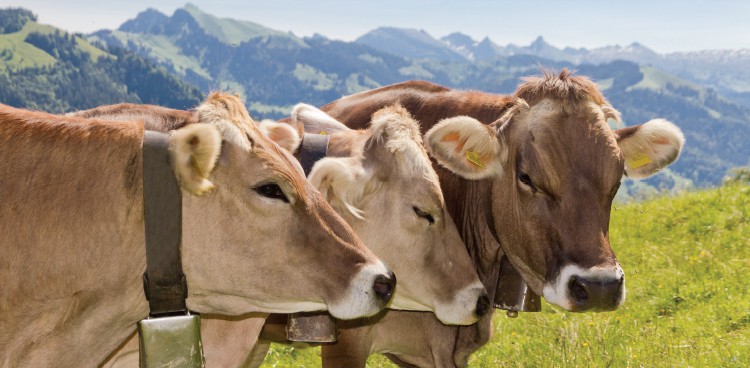
Brown Swiss cows, known for their docile temperament, hail from—where else?—Switzerland. Some historians contend that the breed is centuries old, dating as far back as 4000 BCE. By comparison, the breed is quite new to America, having arrived in 1869, when Henry M. Clark brought seven pregnant heifers and one bull to Massachusetts. Bred to be adaptable to the harsh terrain and weather of its homeland, Brown Swiss is a hardy breed that thrives in most regions. It has grown in popularity and is now reported to be the second most common cattle breed in the world (behind Holstein).
Appearance & Temperament
Brown Swiss cows’ coats are a variety of colors, including gray, brown, and white. Nearly all have a white muzzle with a dark nose, and their large, floppy ears give them an eager and friendly appearance. Their “correct” legs and feet and “well-attached” udders—which are less susceptible to disease and injury than those of many other cows—make them excellent dairy animals.
The breed has a strong natural grazing instinct, but also a responsive demeanor—helpful attributes on the pasture, since when you lead one cow, the rest of the herd will usually follow.
Milk & Cheese
On average, Brown Swiss produce about 46 pounds of milk per day. The breed is lauded for its exceptional milk quality, with a butterfat-to-protein ratio around 3 or 4 percent. While this may mean little to the average person, it makes an impact when it comes to a cheese’s flavor and texture, says Kate Turcotte. As the head cheesemaker at Vermont’s Shelburne Farms, which has a herd of 125 Brown Swiss, Turcotte uses the milk to make 170,000 pounds of top-shelf cheddar every year.
“In cheese, the protein is the building block—the structure of the cheese—and the fat fits within that structure to create flavor and depth,” she says. “If the protein is low, then the cheese yield will be low, and if the butterfat is too low, it won’t have good flavor.”
Besides having noticeable advantages in milk taste, Brown Swiss can usually produce milk for a longer period of time than other cows. Brown Swiss are slower growing and later to mature, but they are also longer-lived. Holsteins have an average milk production expectancy of six years; it’s not unheard of for Brown Swiss to produce for more than 10.




